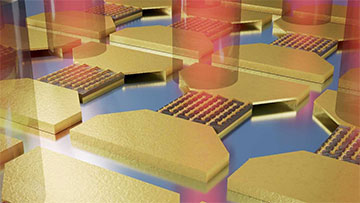
Researchers at ETH Zurich have demonstrated a new kind of ultrafast graphene photodetector relying on rows of tiny gold antennas. This artist’s impression shows an array of such devices, each directly illuminated from above by a single-mode fiber. [Image: S. Koepfli, Institute of Electromagnetic Fields, ETH Zurich, Switzerland]
Among the long list of dazzling properties of graphene is its extremely quick response to incoming light, potentially leading to a new kind of ultrafast photodetector that could meet the ever-growing demand for internet bandwidth. But the exceptional thinness of graphene—which consists of single sheets of carbon just one atom thick—means that it absorbs light poorly, typically tapping only about 2% of a laser beam’s energy.
Now scientists in Switzerland say they have shown how graphene’s lightning speed might be exploitable after all, by integrating it with a tailor-made infrared absorber—a metamaterial consisting of an array of tiny gold antennas (Science, doi: 10.1126/science.adg8017). The researchers have reportedly demonstrated a world-record photodetection bandwidth of 500 GHz combined with a flat frequency response across a broad part of the near-infrared spectrum. Although the device’s overall absorption still remains fairly low, they reckon that its ability to deal with high input powers combined with further design optimizations could enable a new generation of graphene-based photodetectors.
Gold-based metamaterial
To date, many researchers developing graphene-based photodetectors have sought to overcome the material’s poor absorption by incorporating devices within photonic integrated circuits. This approach has the merits of speed and applicability across a broad spectral range. However, that range can only be accessed in its entirety by varying a circuit’s geometry.
For their solution to the absorption problem, Stefan Koepfli, Juerg Leuthold and colleagues at ETH Zurich instead look to a gold-based metamaterial illuminated in free space by a single-mode fiber.
For their solution to the absorption problem, Stefan Koepfli, Juerg Leuthold and colleagues at ETH Zurich instead look to a gold-based metamaterial illuminated in free space by a single-mode fiber. Their device has five layers, with the lowest two layers consisting of a gold reflecting backplane and a spacer made from aluminum oxide. Above that is a single layer of graphene, with the metamaterial attached, followed by a passivation layer of aluminum oxide to cap the device.
The metamaterial consists of a 10 × 10 array of roughly 250-nm-long dipole antennas, which are fabricated as periodic broadenings of a narrow gold wire and placed 1 µm apart. The antennas respond to the electric field of infrared waves by generating electromagnetic hotspots in their vicinity, some of the energy from which is absorbed by the graphene. (This process is enabled by n-type and p-type doping created by the alternating gold and silver contacts.)
Strong signal, high bit rate
To test their device’s response speed, Koepfli and colleagues subjected it to laser beats with frequencies between 2 and 500 GHz. The device generated a strong signal across the entire range, remaining consistently above –3 dB, with the upper end of the range corresponding to the highest ever bandwidth for a photodetector. They also recorded a higher bit rate than any other graphene detector—measuring 132 Gbit/s using a binary modulation of the laser pulse amplitude.
This tolerance to high powers should partly compensate for the lower responsivity, the researchers argue, given the greater absolute currents created as a result.
Notwithstanding the metamaterial’s exceptional absorption, the ETH team recorded what it admits is a low responsivity (the ratio of current-out to optical power–in)—just 0.75 mA/W. This implies that the device requires some 1000 photons for each electron-hole pair it creates, compared with just 10 photons per pair for state-of-the-art photodiodes. But the researchers point out that the relationship between current and power remains linear all the way up to 200 mW, with destructive testing of similar devices showing no damage below 1 W.
This tolerance to high powers should partly compensate for the lower responsivity, the researchers argue, given the greater absolute currents created as a result. In any case, they say that previous demonstrations of graphene photodetectors illuminated in free space show the potential for boosting responsivity—devices based on carrier multiplication or exfoliated multilayer graphene having already achieved higher responsivities without optical enhancement (such as the use of metamaterials).
In addition, Koepfli and colleagues found that their device had excellent spectral characteristics, with a flat response across a 200-nm-wide spectral band and central wavelengths from 1400 to 4200 nm and beyond. They also made antennas with 30 different lengths and demonstrated in each case an absorption resonance in line with simulations. What’s more, they fabricated one device with antennas of two different lengths interspersed with one another to show that each antenna could respond separately to its particular resonance frequency—a potentially handy attribute, they point out, in the push for new telecom bands.
Straightforward design
In addition, Koepfli and colleagues found that their device had excellent spectral characteristics, with a flat response across a 200-nm-wide spectral band and central wavelengths from 1400 to 4200 nm and beyond.
The researchers add that the graphene device has a number of other plus points. For one, they say, its relatively straightforward five-layer stacking of metal, insulator, graphene, metal and insulator is compatible with almost any kind of substrate. They also note that they obtained their results, in contrast to those of most previous graphene detectors, without cooling or vacuum conditions, and they used gate voltages compatible with CMOS technology.
The researchers say they are now working toward a photodetector with higher responsivity but do not wish to provide any details about the new work at this stage.
